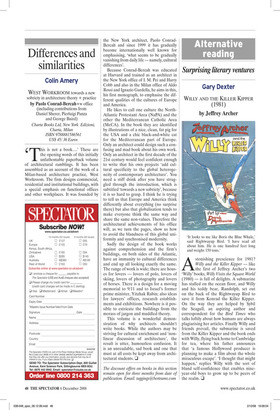Differences and similarities
Colin Amery
WEST WORKROOM towards a new sobriety in architecture theory + practice by Paolo Conrad-Bercah+w office (including contributions from Daniel Sherer, Pierluigi Panza and George Baird) Charta Books Ltd, New York Edizioni, Charta, Milan ISBN 9788881586561 US$ 45/ 36 Euros ‘This is not a book....’ These are the opening words of this initially unfathomable paperback volume of architectural ramblings. It has been assembled as an account of the work of a Milan-based architecture practice, West Workroom. The firm designs commercial, residential and institutional buildings, with a special emphasis on functional offices ub_sp_111008qd 7/1008 1 and other workplaces. It was founded by the New York architect, Paolo ConradBercah and since 1999 it has gradually become internationally well known for emphasising, ‘what seems to be gradually vanishing from daily life — namely, cultural differences’.
Because Conrad-Bercah was educated at Harvard and trained as an architect in the New York office of I. M. Pei and Harry Cobb and also in the Milan office of Aldo Rossi and Ignazio Gardella, he aims in this, his first monograph, to emphasise the different qualities of the cultures of Europe and America.
He likes to call one culture the NorthAtlantic Protestant Area (NaPA) and the other the Mediterranean Catholic Area (MeCA). In the book they are identified by illustrations of a nice, clean, fat pig for the USA and a chic black-and-white cat for the Mediterranean part of Europe. Only an architect could design such a confusing and mad book about his own work. Only an architect in the first decade of the 21st century would feel confident enough to write that his own projects ‘add cultural specificity to the global heterogeneity of contemporary architecture’. You need a stiff drink after you have struggled through the introduction, which is
44
subtitled ‘towards a new sobriety’, because it is so hard to grasp. I think he is trying to tell us that Europe and America think differently about everything (no surprise there) but also that globalisation tends to make everyone think the same way and share the same non-values. Therefore the architectural achievements of his office will, as we turn the pages, show us how to avoid the blandness of this global uniformity and synchronised modernity.
Sadly the design of the book works against comprehension and the firm’s buildings, on both sides of the Atlantic, have an immunity to cultural differences and end up all looking exactly the same. The range of work is wide; there are houses for lovers — lovers of polo, lovers of skiing, lovers of photography and lovers of horses. There is a design for a moving memorial to 9/11 and to Israel’s former prime minister, Yitzhak Rabin; also ideas for lawyers’ offices, research establishments and exhibitions. Nowhere is it possible to extricate the buildings from the morass of jargon and muddled theory.
This volume is a wonderful demonstration of why architects shouldn’t write books. While the authors may be striving for cultural enrichment and ‘nonlinear discussion of architecture’, the result is utter, humourless confusion. It is an unreadable, sad book and one that must at all costs be kept away from architectural students. ❑ The discount offers on books in this section remain open for three months from date of publication. Email: taggings@bertrams.com


















































































 Previous page
Previous page